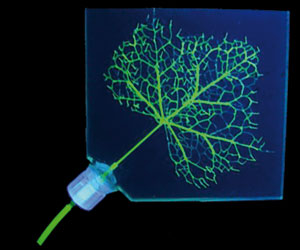A new method to make complex microvascular networks could revolutionise tissue engineering, claim US scientists.
Nature is full of examples of vascular networks, such as blood vessels in the human body and veins in leaves that transport fluid or other substances to promote growth and healing. Jennifer Lewis at the University of Illinois and colleagues have developed a technique to mimic these networks on a polymer matrix. The polymer system makes it capable of self healing, allowing any cracks or tears to be healed making it stronger and more durable than previous attempts.
Microvascular networks, such as those found in leaves, can be made
|

Lewis's networks were created using a wax-based organic ink to write the patterns using a single 10 µm nozzle. By altering the writing speed and pressure, Lewis was able to vary the size of the microfluidic channels, eliminating the need for different nozzle sizes. When the pattern is complete the temperature is raised to liquefy the ink and remove it using a vacuum. The completed microchannel network is left in the polymer.
Lewis used the technique to produce a variety of patterns including a square matrix, three generation structure that mimics the veins in an ivy leaf and a six generation network with many more branches then previously possible.
The fluid transport was most efficient when the network structure was designed in accordance with Murray's law, which is a formula for relating the radii of daughter branches to the radii of the parent branch of biological tubular systems, explains Lewis.
The future for these systems would appear to be very promising for many applications says Lewis. 'These novel constructs offer a potential new platform for tissue engineering,' she adds.
Paul Cooper
Enjoy this story? Spread the word using the 'tools' menu on the left or add a comment to the Chemistry World blog.





